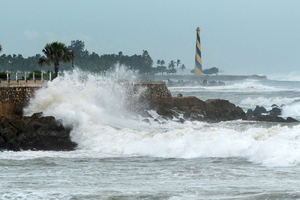America
Eight Killed in Southern U.S. by Storm Beryl

Houston, Texas, July 10 :
After downgrading to a post-tropical cyclone on July 9, storm Beryl destroyed trees and caused major flooding in the southern United States, killing at least eight people. Authorities reported one death in adjacent Louisiana and seven in Texas, when Beryl made landfall as a Category 1 storm early July 8. After Beryl ripped through the Caribbean last week—at one time reaching the strongest hurricane ever recorded—the death toll is now at least 18.
Despite predictions of temperatures reaching 41C (106F) with humidity included, almost 2.2 million homes in Texas remained dark owing to broken power grids. Power was out to an additional 14,000 houses in Louisiana. Residents were relocated to air-conditioned shelters as crews tried to restore service.
According to the US National Hurricane Center, Beryl showed signs of weakening on July 9 and was now moving northeast into Canada with winds of 30 miles per hour (45 kilometers per hour). The center warned that Beryl could still produce tornadoes and flooding.
Flooding and hurricane-force winds devastated the enormous metropolis of Houston, which is home to some 2,300,000 people. Two victims, a man of 53 years and a woman of 74 years, lost their lives when trees crashed into their homes, according to Ed Gonzalez, the sheriff of Harris County, who made the announcement on X.
A police officer drowned in floodwaters en route to work, and another person died when a lightning strike may have started a fire, according to a news conference later held by Houston Mayor John Whitmire. In Louisiana, the Bossier Parish sheriff's office reported one fatality, which was likewise caused by a tree falling on a home. According to 51-year-old Rose Michalec, Beryl tore down fences in the neighborhood where she lives in south Houston. The amount of damage is substantial... "It's beyond our expectations," she remarked.
Floyd Robinson, 76 years old, often walks in the park in downtown Houston, which was one of several sites flooded. This kind of harmful water is appearing more frequently than I've ever seen it before, the lifelong Houston native told . A storm of this size rarely hits our area, and we're only in the first week of July. The roofs of numerous waterfront homes and businesses along the Texas coastline were ripped off by the wind.
After a Category 4 hurricane hit Grenada and Saint Vincent and the Grenadines, Beryl plowed into Jamaica and the Cayman Islands, eventually intensifying to a Category 5. On July 5, it made landfall in Mexico, destroying trees and lampposts and ripping tiles off roofs.
Three persons perished in Grenada, two in St. Vincent and the Grenadines, three in Venezuela, and two in Jamaica as a result of Beryl's wrath.
Since the National Hurricane Center started keeping track in June, this storm is the first to reach Category 4, and it was the first to reach Category 5 in July. Michael Lowry, an expert on hurricanes, has said that Beryl will be the first storm to hit Texas in ten years. Storms of this magnitude seldom develop so early in the Atlantic hurricane season (beginning in early June and ending in late November). Due to the increased energy available in a warmer ocean, scientists believe that climate change contributes to the fast intensification of storms like Beryl.







































